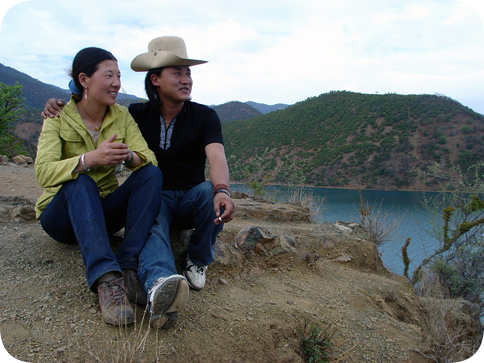The Fall of Womenland
Directed by Xiaodan He, 2009, 46 minutes.
Study areas: China, Gender Roles, Ethnicity, and Politics of Representation

The Fall of Womenland is a fascinating documentary that takes the relatively large field of films about the Moso people of China in a somewhat different direction than one might expect. Created by He Xiaodan, a filmmaker of Naxi ethnicity now living in Canada, The Fall of Womenland was partially funded by the National Geographic’s All Roads Film Project. The film uses first-person narration to give the viewer an intimate look at southwest China’s Moso villages —perhaps too intimate at times, as I discuss below. On a technical level, the careful crafting of storyline, sound, and visuals is clear, with the excellent cinematography by Martin Doepner making the documentary aesthetically pleasing.
The film opens with footage from the Chinese Historical Ethnographic Film Series (Yang Guanghai 1965), interspersed with recollections from elderly Moso women living in Lige Village recalling past relationships. The Fall of Womenland discusses the practice that Moso call tisese in their language and zouhun in Chinese, a ‘walking marriage’ in which women receive their lovers at night, but each partner works and lives with their own natal family. The freedom of women like Bima, a woman from Lige profiled in the film, to choose their partners and play prominent roles in their birth households, is the purported basis for the ‘womenland’ described in the film’s title. Whether this society is truly a heaven for women or rather, a paradise for men, is a question explored throughout the film.
One of the strengths of this film is that He Xiaodan achieves a rapport with her subjects such that they willingly reveal intimate details of their lives at which other films only hint. For example, many documentaries mention prostitution as a dark side of tourism but lack strong visual evidence to accompany the narrator’s ominous words. Some simply show people walking down a dark street at night as they describe this new form of sexual exchange. The Fall of Womenland, by contrast, portrays the less formal prostitution targeted to locals, not tourists, through interviews with a young female bar manager and with young men who patronize these bars. The men both bemoan the lack of ‘traditional’ romantic partners who do not accept paid clients and describe their desires to taste ‘many flavors.’
This intimate portrayal grows uncomfortable at times, as when the camera lingers at the open-air hot springs, raising questions about the ethics of filming nude bathers. Even if the filmmaker wants to emphasize the healthy relationship to sexuality espoused by Moso people, this practice bears a troubling resemblance to the historical film mentioned earlier, and others like it, that paid little attention to Moso modesty taboos and instead cared more about proving their theoretical points. In an otherwise respectful film, these scenes, along with the explicit images from the family planning office accompanied by slow-tempo music, seem out of place.
Overall, however, this film contributes an intriguing perspective: that of He Xiaodan trying to make sense of her own life and identity by examining changing identities in Moso communities. While I do not find convincing the argument that the life decisions of the film’s protagonists, or even the existence of prostitution, evoke the downfall of a ‘womenland,’ the film’s other strengths make this recommended viewing. It is best suited for high school and college students in courses exploring gender roles, ethnicity, and the politics of representation.
Author’s Note: In the interest of full disclosure, I have known He Xiaodan since 1999, when I acted in a feature film that she helped produce for the Yunnan Minority Film Studio. When she decided to make this film, I introduced her to Bima, one of the film’s protagonists. Thus I am not an entirely impartial reviewer.
Tami Blumenfield, PhD is a Visiting Assistant Professor of Asian Studies and International Studies at Portland State University. She received her doctorate in Sociocultural Anthropology from the University of Washington in 2010. Tami has done long-term ethnographic fieldwork in ethnically diverse regions of southwest China since 2001. Her dissertation, Scenes from Yongning: Media Creation in China’s Na Villages, examined the intersections of participatory media production, national media policy, ethnicity and tourism in Yunnan Province.
The Fall of Womenland is distrubuted in the U.S. by The Cinema Guild
DVD price: $295.00; Classroom Rental $85.00
Prices include institutional public performance rights.
Last Updated: June 26, 2011

